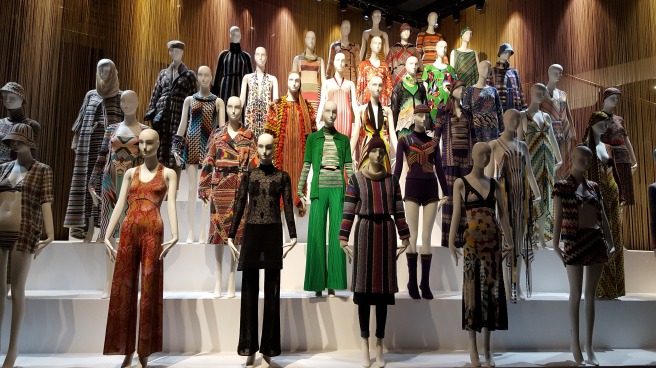
London’s Fashion and Textile Museum is currently hosting a rather interesting show celebrating the relationship between Italian textile titan, Missoni and modern art. Missoni Art Colour runs until 4 September so if you find yourself in London before then, be sure to check it out.
What makes it interesting? First there is the industrial concept here. Italy prides itself on its manufacturing quality and artistry, especially in the fashion industry. Missoni’s founders, Ottavio and Rosita Missoni worked very much in that tradition, creating textiles inspired by 20th century fine art, whilst also being deeply rooted in Italy’s industrial heritage. The result was the creation of a highly individualistic label, immediately recognisable and distinctive to anyone in world of international fashion.
It is also interesting to see the textiles and the clothes displayed alongside the art. I had never before appreciated the relationship between a Missoni zig-zag knit piece and abstract art of the mid-twentieth century but in this show, the connection is clear. See below left, artwork by Ottavio Missoni, ‘Untitled’ 1973 and right, Missoni textile sample.
It boasts fashion over a period of 60 years, from 1953 to the present, with paintings by Sonia Delaunay, Lucio Fontana and Gino Severini, as well as textile studies, paintings and Arazzi by Ottavio Missoni. Some of the art has come from the Missoni collection and some from the MA*GA Art Museum, Gallarate and from private collections in Italy. Most have never before been exhibited in the UK.
The very best fashion exhibitions cause you to stop short and find a new perspective on a designer or piece of clothing. This show certainly did that for me and I’ll be seeing Missoni, both new but especially vintage, in a new and highly artistic light. See this at London’s Fashion and Textile Museum before 4 September.













![20160710_151316[1]](https://nellvoyager.wordpress.com/wp-content/uploads/2016/07/20160710_1513161.jpg?w=575&h=1024)
![20160710_151307[1]](https://nellvoyager.wordpress.com/wp-content/uploads/2016/07/20160710_1513071.jpg?w=169&h=300)
![20160624_131057[1]](https://nellvoyager.wordpress.com/wp-content/uploads/2016/07/20160624_1310571.jpg?w=168&h=300) M Saillard’s genius curation always delivers a fresh perspective on fashion and on the clothes we put on our back every day. However serious my intentions though, I can’t quite resist the impulse to choose something I’d like to walk away with, given the chance. I’m still dreaming about a stunning Jean Patou black velvet evening coat – a marvel of 1930s couture with a sleekly wrapped body invisibly fastened offset beautifully with a wide shawl collar and bell-like kimono sleeves with the largest cuffs I’ve ever seen. There is a reason that French haute couture leads the world – this show tells you why. See it before 23 October.
M Saillard’s genius curation always delivers a fresh perspective on fashion and on the clothes we put on our back every day. However serious my intentions though, I can’t quite resist the impulse to choose something I’d like to walk away with, given the chance. I’m still dreaming about a stunning Jean Patou black velvet evening coat – a marvel of 1930s couture with a sleekly wrapped body invisibly fastened offset beautifully with a wide shawl collar and bell-like kimono sleeves with the largest cuffs I’ve ever seen. There is a reason that French haute couture leads the world – this show tells you why. See it before 23 October.